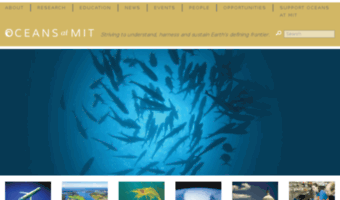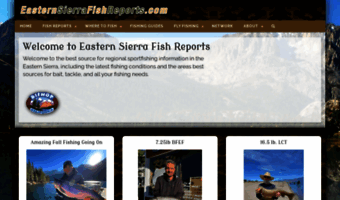Oceans MIT. The coastal oceans are the most fished, most modified, and most vulnerable areas to storms and pollution.
Never miss Oceans.mit.edu updates: Start reading the news feed of Oceans MIT right away! This site’s feed is stale or rarely updated (or it might be broken for a reason), but you may check related news or Oceans.mit.edu popular pages instead. It is generally safe for browsing, so you may click any item to proceed to the site.
News, stories and media buzz related to Oceans MIT
-
Research enables fishermen to harvest lucrative shellfish on Georges Bankvia
sciencerelief.blogspot
Scientists have known for many years that the phytoplankton Alexandrium fundyense is the cause of the harmful algae blooms that occur to varying severity each spring and summer along the coastal Gulf of Maine, sometimes extending as far south as Cape...
-
Searching for Lost Knowledge in the Age of Intelligent Machinesvia
theatlantic
The most mysterious technological object on the planet should have been destroyed at least three times. First, the device made it through a violent shipwreck in the Mediterranean Sea. Then, it sat submerged in salt water on a sandy cliff 200 feet below...
-
PlanetSolar — World’s Largest Solar Boat — Arrives in Boston!via
cleantechnica
This article first appeared on 1sun4all. MS Tûranor PlanetSolar, the world’s largest solar-powered boat, with her crew and scientists onboard, arrived in Boston to continue her 2013 “PlanetSolar DeepWater” expedition. ...
-
Emerging Underwater Businesses: Three Companies to Notevia
everything-robotic
By Frank Tobe. Publisher, The Robot Report Woods Hole Oceanographic Institute's Sentry ROV We've read about their use in last year's Deepwater Horizon Gulf of Mexico oil spill and their underwater repair work, traipsing the corridors and collecting...
-
FOR IMMEDIATE RELEASE: July 20, 2012 CONTACT: Diana Kenney, Marine Biological Laboratory, 508-289-7139; dkenney@mbl.edu Plans for the National Science Foundation’s cabled seafloor observatory at Axial Seamount (inset), west of the Oregon coast. Credit...
Observe Oceans.mit.edu news and updates
-
Video by MIT’s Laura Castanon, Timothy Dimacali, Lochie Ferrier, and Tristan Honscheid Can you teach a marine robot to be curious about its environment? MIT-WHOI Joint Program graduate students Genevieve Flaspohler and Kevin Doherty along with WHOI...
-
MIT engineers have designed a robotic glider that can skim along the water’s surface, riding the wind like an albatross while also surfing the waves like a sailboat. In regions of high wind, the robot is designed to stay aloft, much like its avian counterpart...
-
A warm EAPS welcome to incoming research scientist Steven Smriga. By Helen Hill | EAPS News Read the full story including incoming EAPS postdocs on EAPS News. Steven Smriga‘s research focuses on marine and aquatic microbial communities, particularly...
-
Omta, A. W., Ferrari, R., & McGee, D. (2018), An analytical framework for the steady state impact of carbonate compensation on atmospheric CO2, Global Biogeochemical Cycles, 32, 720–735, doi: 10.1002/2017GB005809 Abstract The deep-ocean carbonate...
-
Observing the world’s oceans is increasingly a mission assigned to autonomous underwater vehicles (AUVs) — marine robots that are designed to drift, drive, or glide through the ocean without any real-time input from human operators. Critical questions...
You may also like
MiniWrites – A hub for your creative projects!
A hub for your creative projects!
academics
Oceans.mit.edu popular pages
-
Coral Reefs and Sinking Islands: Revisiting Darwin’s Other Theory | Oceans at MIT
Coral Reefs and Sinking Islands: Revisiting Darwin’s Other Theory by Genevieve Wanucha The coral reefs encircling many volcanic ocean islands of the South Pacific appear in one of three forms. Tahiti’...
-
Evolution of Oceans and Life | Oceans at MIT
Reconstructing the Parallel Evolution of Life and Oceans Sedimentary rocks store most records of past life and biogeochemical processes. Reconstructions of these records illuminate interactions betwee...
-
Oceans at MIT | Striving to understand, harness and sustain Earth's defining frontier.
Ocean Engineering at MIT Emerging technologies such as under-water robots and sonar communication tools usher in a new era of autonomous ocean exploration. Coastal Oceans With half of all people livin...
Some worthy website to observe next
Website parameters
-
39 years
Domain age
-
N/A
Visit duration
-
N/A
Daily visitors
-
N/A
Bounce rate
Reputation
Excellent
Child safety
Excellent
Trust
Excellent
Privacy
Audience origins
-
25.2 %
USA
-
10.4 %
China
-
8.2 %
India
-
4.7 %
United Kingdom
-
2.5 %
Canada








